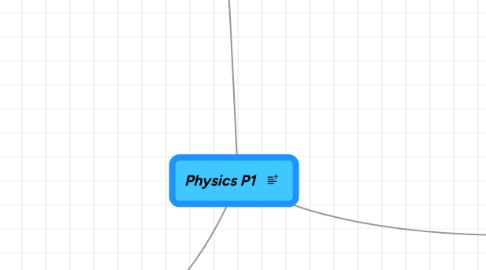
1. Waves
1.1. Reflection
1.1.1. Mirrors
1.1.2. The Normal
1.1.3. Angle of Incidence = Angle of Reflection
1.1.4. Beyond the Critical Angle there is Total Internal Reflection
1.1.4.1. Optical Fibres
1.1.4.1.1. Communication
1.1.4.1.2. Endoscopes in Hospitals
1.2. The Electromagnetic Spectrum
1.2.1. Radiowaves
1.2.1.1. Terrestrial TV and Radio (Freeview)
1.2.2. Microwaves
1.2.2.1. Oven
1.2.2.2. Mobile phone communication
1.2.2.3. Satellite TV transmission
1.2.3. Infra Red
1.2.3.1. Remote Controls
1.2.3.2. Heat sensing or Thermal Imaging
1.2.4. Visible Light
1.2.4.1. Telescopes
1.2.4.2. Cameras
1.2.4.3. Eyesight
1.2.5. Ultra-Violet
1.2.5.1. Sunbeds
1.2.6. X-Rays
1.2.6.1. Produces an image of the body
1.2.6.2. Also used to study matter in labs
1.2.7. Gamma Rays
1.2.7.1. Sterilize food and medical instruments
1.2.7.2. Cancer treatment
1.3. Refraction
1.3.1. Light changes speed and direction going from one medium to another
1.3.2. Bends toward the Normal going from Air to Glass (low to high density)
1.3.3. Bends away from the Normal going from Glass to Air (high to low density)
1.4. Basics of waves
1.4.1. Amplitude: The greatest displacement of the wave from its rest position (ie height of peak from middle)
1.4.2. Wavelength:The distance of one complete cycle of a wave (for example, peak to peak),(Units metres)
1.4.3. Frequency: The number of waves passing a given point per second (Units Hertz or Hz)
1.4.4. Wave Speed = Distance/Time
1.4.5. Wave Speed = Wavelength x Frequency
2. Energy
2.1. Forms
2.1.1. Light (solar)
2.1.2. Electrical
2.1.3. Nuclear (atomic)
2.1.4. Elastic potential (strain)
2.1.5. Heat (thermal)
2.1.6. Sound
2.1.7. Kinetic (movment)
2.1.8. Gravitational potential
2.1.9. Chemical
2.2. Energy Resources
2.2.1. Non-renewable
2.2.1.1. Fossil Fuels
2.2.1.1.1. Oil
2.2.1.1.2. Natural Gas
2.2.1.1.3. Coal
2.2.1.2. Nuclear
2.2.1.2.1. Good: Very concentrated, lots of reserves, no effect on global warming
2.2.1.2.2. Bad: Radioactive waste, non renewable, expensive to build and decommisson
2.2.2. Renewable
2.2.2.1. Wind
2.2.2.1.1. Good: Renewable, no pollution, low running cost
2.2.2.1.2. Bad: Not concentrated, unsightly, output not constant
2.2.2.2. Wave
2.2.2.2.1. Good:Renewable, out of sight,
2.2.2.2.2. Bad: Not concentrated, early in their development
2.2.2.3. Tidal
2.2.2.3.1. Good: Renewable, low running cost
2.2.2.3.2. Bad: Expensive to buil, habitat damage, output not constant
2.2.2.4. Biomass
2.2.2.4.1. Good: Overall no CO2 pollution, renewable
2.2.2.4.2. Bad: Not concentrated, burning used
2.2.2.5. Hydroelectric
2.2.2.5.1. Good: Renewable, low running cost
2.2.2.5.2. Bad: Expensive to build, floods valleys
2.2.2.6. Geothermal
2.2.2.6.1. Good: Renewable, no pollution
2.2.2.6.2. Bad: Only used in certain places on earth with thin crust
2.2.2.7. Pumped storage: Used to store energy until peak times
2.2.3. Combined Heat and Power Stations are more efficient than old thermal ones
2.3. Electricity Bills
2.3.1. number of units used (kWh) = Power (kW) x time (h)
2.3.2. cost=number of units x cost per unit
2.3.3. Insulating a house can save money and energy (eg loft insulation, draughtproofing, double glazing)
2.4. Heat Transfer
2.4.1. Conduction
2.4.1.1. Metals are good conductors and non-metals poor conductors in general
2.4.1.1.1. Materials containing trapped air are very poor conductors (insulators)
2.4.2. Convection
2.4.2.1. Important for fluids (gases and liquids)
2.4.2.1.1. Hot fluid rises and takes heat energy with it
2.4.3. Radiation
2.4.3.1. Travels as EM radiation and can travel across a vacuum at the speed of light
2.4.4. Matt black surfaces are best emitters and absorbers of radiation. Silvered surfaces are the worst
2.5. Efficiency
2.5.1. Efficiency = (Useful Energy/Total Input Energy) x 100%
2.5.2. Energy saving measures
2.5.2.1. Photovoltaic solar panels
2.5.2.2. Thermal solar panels
2.5.2.3. Wind turbines
2.5.2.4. Payback time= Initial cost / savings per year
2.6. National Grid
2.6.1. Network of pylons connects homes and businesses to power stations
2.6.1.1. Use high voltage in transmission to save losing energy in heat loss.
2.6.1.1.1. Power (W) = Voltage (V) x Current (A)
2.6.1.1.2. Use transformers to step voltage up and down
2.6.1.1.3. Energy transferred(J)= Power (W) x Time (s)
2.6.1.1.4. 1 kW = 1000 W
3. Space
3.1. The Solar System
3.1.1. M V E M J S U N P
3.1.1.1. Inner planets rocky
3.1.1.2. Outer planets Gas Giants
3.2. Stars
3.2.1. The Sun is a star relatively near to us (8 lightminutes)
3.2.2. Stars burn hydrogen (nuclear fusion), emit light and heat
3.2.2.1. In nuclear fusion 2H= He + lots of energy
3.2.3. Apart from our Sun, nearest star is 4 lightyears away (Alpha Centauri)
3.2.4. Lightyear is the distance light travels in a year: Distance=Speed x Time = 300000000 x (60x60x24x365)
3.3. Galaxies and the Universe
3.3.1. Our galaxy is a spiral called the Milky Way
3.3.1.1. Nearest galaxy to us is Andromeda
3.3.2. All galaxies seem to be moving away from each other
3.3.2.1. Red Shift (Doppler Effect)
3.3.2.1.1. Example:Ambulance siren going past someone
3.3.2.1.2. Evidence of Big Bang
3.3.3. The Big Bang Theory
3.3.3.1. Other evidence is Cosmic Microwave Background Radiation
